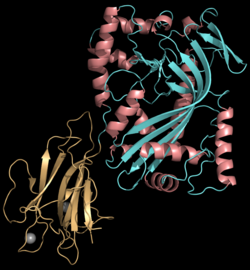穿孔素
来自维基百科,自由的百科全书
穿孔素(英語:Perforin)是人體內一類由PRF1基因编码的蛋白質[2][3][4]。
| 穿孔素1 Perforin 1 | |||
|---|---|---|---|
 | |||
| 标识 | |||
| 代号 | PRF1; FLH2; HPLH2; P1; PFN1; PFP | ||
| 扩展标识 | 遗传学:170280 鼠基因:97551 同源基因:3698 ChEMBL: 5480 GeneCards: PRF1 Gene | ||
| RNA表达模式 | |||
 | |||
| 更多表达数据 | |||
| 直系同源体 | |||
| 物种 | 人类 | 小鼠 | |
| Entrez | 5551 | 18646 | |
| Ensembl | ENSG00000180644 | ENSMUSG00000037202 | |
| UniProt | P14222 | P10820 | |
| mRNA序列 | NM_001083116 | NM_011073 | |
| 蛋白序列 | NP_001076585 | NP_035203 | |
| 基因位置 |
Chr 10: 72.36 – 72.36 Mb |
Chr 10: 61.3 – 61.3 Mb | |
| PubMed查询 | [1] | [2] | |
功能
穿孔素是一種由细胞毒性T细胞或自然殺傷細胞分泌的細胞溶解蛋白質。它們會插入靶細胞的細胞膜中,並形成孔隙。穿孔素的MACPF域能夠促使細胞溶解[5]。該域與革蘭氏陽性菌的膽固醇依賴性溶細胞素有一定的同源型[1]。
穿孔素在結構上和功能上與補體成分9(C9)具有一些共同點。比如說,穿孔素可以像補體成分9那樣在細胞膜上形成能夠非特異性地裂解多種靶細胞的孔洞。穿孔素是促細胞溶解顆粒中的一種主要促細胞裂解蛋白,在由T細胞和天然殺傷細胞介導的細胞溶解中起關鍵作用[4]。它通過在細胞膜上產生孔洞,從而讓鈣離子大量流入細胞,使得靶細胞啓動細胞膜的修復機制。上述的修復機制可讓穿孔素和顆粒酶進入早期內涵體[6]。
臨床意義
有缺陷的PRF1等位基因純合會導致2型噬血細胞综合癥,一種罕見的致死性幼年期常染色體隱性遺傳病[4]。
相互作用
參見
參考
拓展閱讀
外部連結
Wikiwand - on
Seamless Wikipedia browsing. On steroids.
